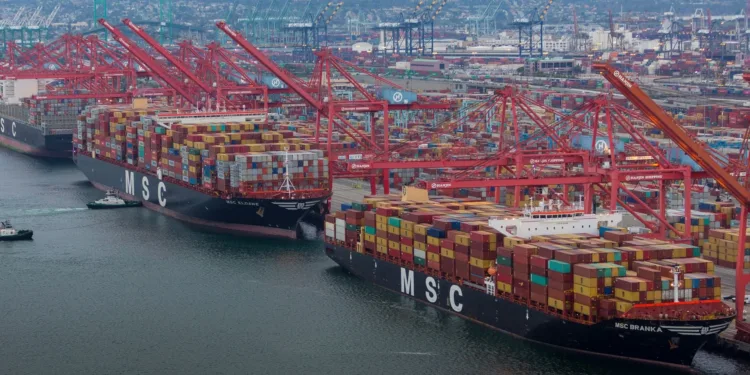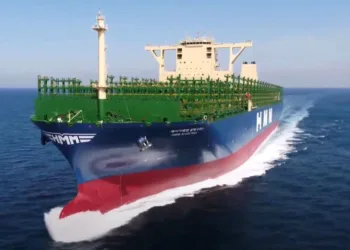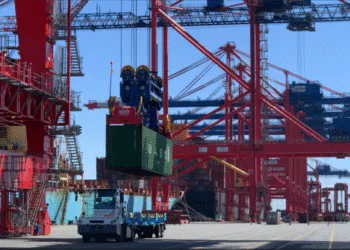The container shipping industry faced a challenging second quarter in 2025, recording its third consecutive quarterly decline in earnings.
The industry’s net income fell to $4.4 billion, a 56% drop from the first quarter’s $9.9 billion and a 63.7% decrease from the $12 billion earned in the second quarter of 2024. This decline is attributed largely to the ongoing impacts of tariffs and shifting trade policies, particularly involving the United States, said analyst John McCown in a report.
The imposition of tariffs by the Trump administration has significantly disrupted trade flows, leading to a pronounced downtrend in inbound U.S. container volumes. This disruption is forecasted to continue, with the National Retail Federation estimating a 5.6% decrease in U.S. inbound volume for the entire year of 2025 compared to 2024. As a result, the second quarter set in motion a ripple effect across the global container shipping network, particularly affecting trade lanes that connect the Asia-Pacific region with North America.
Despite adverse U.S. volume trends, McCown said some mitigating factors have been observed in other regions. Increased shipping volumes to North America, excluding the U.S., and Africa helped offset some of the volume declines. However, these increases fell short of significantly impacting the broader trends. The overall global container volume rose by 4.1% in the second quarter, representing a deceleration from higher growth rates seen in previous quarters.
Tariff-related complexities have not only diminished container traffic but also introduced inefficiencies in maritime operations, leading to increased costs and supply chain disruptions. The recent plan by the United States Trade Representative to impose punitive charges in October on vessels built in China or operated by Chinese carriers, is poised to exacerbate these pressures by driving up operational costs. This policy could lead to vessel realignments and a potential reduction in service, further complicating industry dynamics. Industry sources said the U.S. bulk sector has already seen a withdrawal of Chinese tonnage.
McCown compared the direct impact of tariffs and USTR ship fees with a decrease in commercial activity that could result in fewer jobs for dockworkers, truck drivers and other positions throughout supply chains.
The report said that margins in the container shipping sector have notably contracted. The industry’s net income margin dropped to 6.1% in the second quarter, down from 12.5% in the first quarter of 2025 and a stark decrease from the pandemic-era peak margins. This margin shrinkage underscores the challenging operating environment, marked by increased trade barriers and shifts in global economic policies.
In comparison to the post-pandemic peak earnings periods, current earnings levels are considerably lower. For instance, during the third quarter of 2024, container shipping achieved a collective net income of $26.4 billion, driven by pricing benefits from the Red Sea disruptions. McCown pointed out that while carriers have learned how to turn disruptions into profits, such unprecedented earnings were short-lived, as recovery mechanisms from those unique geopolitical events are unrepeatable under the existing trade landscape.
Looking ahead to the third quarter, McCown said that the outlook remains cautious. The continuation of existing tariffs and trade restrictions is expected to sustain the pressure on earnings. Projections indicate a further sequential decline in net income, potentially down to between $1.9 billion and $2.5 billion. This anticipated decrease reflects not only trade challenges but also the latent impacts of the industry’s expansive capacity management strategies marked by record orders for new tonnage.
There are signals that future adjustments will likely focus on capacity control and strategic alignment with shifting demand patterns. Increasing capacity awareness, coupled with a robust orderbook stemming from recent profit gains, suggests an evolving industry keen on maintaining a balanced approach to supply and demand economics.
Find more articles by Stuart Chirls here.
Related coverage:
Big fish getting better bite at trans-Pacific container spot rates
Trump nominates pair for Federal Maritime Commission
Ocean rates unchanged even as freight volumes decline
Private investor, South Korean conglomerate partner on U.S. maritime initiative
The post Earnings growth outlook ‘bleak’ as ocean shipping profits plunge 56% in Q2 appeared first on FreightWaves.





















